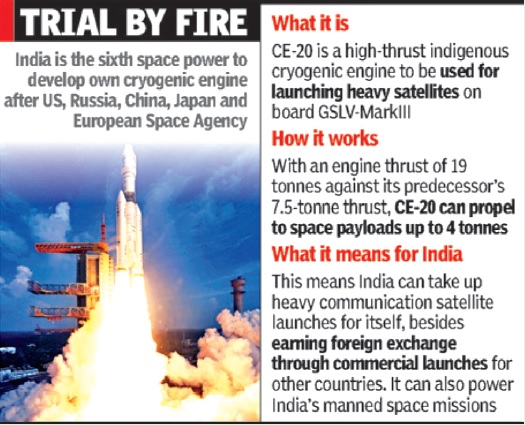India’s space programme has achieved a major breakthrough with the successful testing of a high thrust cryogenic rocket engine, CE-20. This testing gives a major boost to India’s GSLV-Mark III project, aimed at carrying four-tonne payloads, including future manned missions. The CE-20’s testing, the 10th and the longest in the series, lasted up to 800 seconds — 25% more than the burn duration of the engine during flight, ISRO said. On April 28, ISRO had conducted its first full-duration ground test for 645 seconds. Once all trials are successfully completed, the engine will power the upper stage of the Geo-synchronous Satellite Launch Vehicle (GSLV) Mark III. Once operational, this rocket will be used to launch four-tonne class of
satellites. If the human spaceflight programme is cleared by the government, LVM3 .will be the rocket put into use. “After the tests we will go in for the stage assembly. GSLV-MkIII is expected to make its first flight by the end of 2016,” ISRO spokesman Deviprasad Karnik told TOI. The engine’s development is a complicated task that Indian space scientists and engineers have mastered. Cryogenics, the science of very low temperatures, has remained a tricky aff air for rocket scientists across the world.
(Source: The Times of India, Mumbai, July 21, 2015)
Disclaimer: The information provided within this publication / eBook/ content is for general informational purposes only. While we try to keep the information up-to-date and correct, there are no representations or warranties, express or implied, about the completeness, accuracy, reliability, suitability or availability with respect to the information, products, services, or related graphics contained in this publication / eBook/ content for any purpose. Any use of this information is at your own risk.
 Youth
Youth
 Women
Women
 Research for Ishrae
Research for Ishrae







